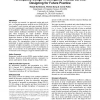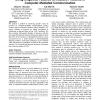CHI
2006
ACM
15 years 25 days ago
2006
ACM
Researchers are using emerging technologies to develop novel play environments, while established computer and console game markets continue to grow rapidly. Even so, evaluating t...
CHI
2006
ACM
15 years 25 days ago
2006
ACM
Mobile interaction can potentially be enhanced with welldesigned haptic control and display. However, advances have been limited by a vicious cycle whereby inadequate haptic techn...
CHI
2006
ACM
15 years 25 days ago
2006
ACM
Although they have potential, to date location-based information systems have not radically improved the way we interact with our surroundings. To study related issues, we develop...
CHI
2006
ACM
15 years 25 days ago
2006
ACM
Fashion signals are displayed to indicate access to information. Consistent, timely, and meaningful signal displays are only made possible if one is well-connected. While fashion ...
CHI
2006
ACM
2006
ACM
Design and experimental analysis of continuous location tracking techniques for Wizard of Oz testing
15 years 25 days ago
Wizard of Oz (WOz) testing has shown promise as an effective way to test location-enhanced applications. However, it is challenging to conduct a location-based WOz test because of...
CHI
2006
ACM
15 years 25 days ago
2006
ACM
It is tedious to handwrite long passages of text by hand. To make this process more efficient, we propose predictive handwriting that provides input predictions when the user writ...
CHI
2006
ACM
15 years 25 days ago
2006
ACM
We describe our research--its approach, results and products--on Danish emergency medical service (EMS) field or "pre-hospital" work in minor and major incidents. We dis...
CHI
2006
ACM
15 years 25 days ago
2006
ACM
We propose a method of measuring people's sense of presence in computer-mediated communication (CMC) systems) based on linguistic features of their dialogues. We create varia...
CHI
2006
ACM
15 years 25 days ago
2006
ACM
We introduce symSpline: a symmetric, dual-mouse technique for the manipulation of spline curves. In symSpline, two cursors control the positions of the ends of the tangent to an e...
CHI
2006
ACM
15 years 25 days ago
2006
ACM
This paper presents descriptive accounts from an ethnographic study of time-critical work in the domain of emergency response and the operative work of fire crews. The verbal comm...


